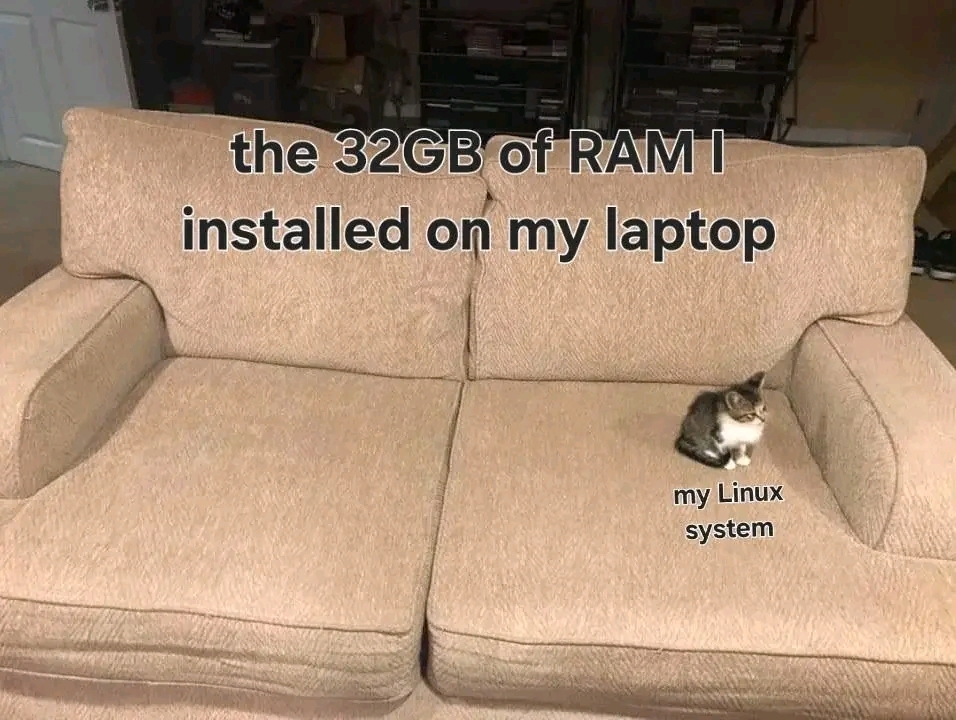this post was submitted on 10 May 2024
1451 points (97.5% liked)
linuxmemes
20880 readers
3 users here now
I use Arch btw
Sister communities:
- LemmyMemes: Memes
- LemmyShitpost: Anything and everything goes.
- RISA: Star Trek memes and shitposts
Community rules
- Follow the site-wide rules and code of conduct
- Be civil
- Post Linux-related content
- No recent reposts
Please report posts and comments that break these rules!
founded 1 year ago
MODERATORS
you are viewing a single comment's thread
view the rest of the comments
view the rest of the comments

Just like the human eye can only register 60fps and no more, your computer can only register 4gb of RAM and no more. Anything more than that is just marketing.
Fucking /S since you clowns can't tell.
Human eye can't see more than 1080p anyway, so what's the point
It doesn't matter honestly, everyone knows humans can't see screens at all
It honestly doesn't matter, reality only exists in your imagination anyway.
Their vision is based on movement.
Human eye can't see more than 8-bit colors anyway, so what's the point
Jokes on you, because i looked into this once. I don't know the exact ms the light-sensitive rods in human eyes need to refresh the chemical anymore but it resulted in about 70 fps, so about 13 ms i guess (the color-sensitive cones are far slower). But psycho-optical effects can drive that number up to 100 fps in LCD displays. Though it looks like you can train yourself with certain computer tasks to follow movements with your eye, being far more sensible to flickering.
Does that refresh take place across the entire eye simultaneously or is each rod and/or cone doing its own thing?
Are your eyeballs progressive scan or interlaced, son?
There's a neuron layer trimming data down to squeeze it through the optical nerve, so... no clue.
According to this study, the eye can see a difference as high as 500 fps. While this is a specific scenario, it’s a scenario that could possibly happen in a video game, so I guess it means we can go to around 500 hz monitors before it becomes too much or unnessessary.
It's not about training, eye tracking is just that much more sensitive to pixels jumping
You can immediately see choppy movement when you look around in a 1st person view game. Or if it's an RTS you can see the trail behind your mouse anyway
I can see this choppiness at 280 FPS. The only way to get rid of it is to turn on strobing, but that comes with double images at certain parts of the screen
Just give me a 480 FPS OLED with black frame insertion already, FFS
Well, i do not follow movements (jump to the target) with my eyes and see no difference between 30 and 60 FPS, run comfortably Ark Survival on my iGPU at 20 FPS. And i'm still pretty good in shooters.
Yeah, it's bad that our current tech stack doesn't allow to just change image where change happens.
This is only true if you're still using a 32 bit cpu, which almost nobody is. 64 bit cpus can use up to 16 million TB of RAM.
Sorry I forgot to put my giant /s.
With PAE, a 32 bit CPU can also use more, but each process is still limited to 4GiB
Bank switching to "fake" the ability to access more address space was a big thing in the 80s...so it's technically possible to access addresses that are wider than the address bus by dividing it up into portions that it can see.
That’s not sarcasm, it’s misinformation. Not surprising that people downvoted you even though it was just a joke.
I don't think that somebody actually read that computers can't register more then 4GiB of RAM and then thought
It certainly used to be true, in the era of 32 bit computers.
That's what makes it a joke. Does anyone here unironcally think the human eye can only see 60 fps or that more than 4 gigs of ram is just marketing?